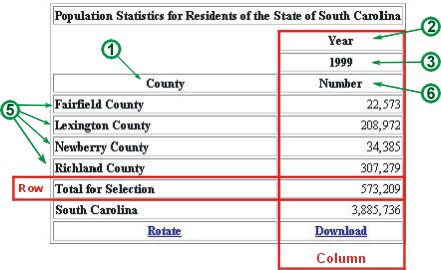The following is an example of a table generated by SCAN using
Population Data .

SCAN users should ask themselves, "What question am I trying to answer?"
or "What am I researching?" Answering these questions will help the user
to determine which variables should be selected during each step of the table creation
process.
For this example, we are interested in determining the population of the counties
in the Palmetto Health District in 1999 in order to calculate several different
rates for this area of the state. In order to generate the above table that answers
our research interests, the following step-by-step process was followed on the "Create
a Table" page:
- STEP 1
-
Step One defines the variable whose levels will occupy the rows of the table. Users
can select year, race, sex, age group, or county. For this example, county
was chosen. We will specify the particular counties we are interested in during
Step 6.
- STEP 2
-
Step Two defines the variable whose levels will occupy the columns of the table.
Users can select year, race, sex, age group, or county. For this example, year
was chosen.
- STEP 3
-
Step Three specifies the years of interest. If year is the chosen row or column
variable, the years you select in this step will occupy the rows or columns of your
table. If year is neither a row nor column variable in your table, all years selected
in this step will be summed together and shown in your table. For this example,
we are interested in the most recent data year, so we selected 1999.
- STEP 4
-
Step Four is an optional step. In this example, we did not make any specifications
here. If we were interested in seeing this same information for a particular combination
of race, sex, and age, this is the step where we would define those levels.
- STEP 5
-
Step Five defines the geographic area to tally for your table. Users can select
the entire state, a single county, or any group of counties. For this example, we
are interested in the Palmetto Health District and a state total which consists
of four counties: Fairfield, Lexington, Newberry, Richland Counties
and South Carolina. The Ctrl key was held down, then South
Carolina, Fairfield, Lexington, Newberry, and Richland Counties were clicked, and
then the Ctrl key was released.
- STEP 6
-
Step Six specifies the numeric output for the table. Users can select from frequencies
only, frequencies and column percents, or frequencies and row percents. Since we
are interested in finding the denominator values for rates, we select frequencies
only.
- SUBMIT REQUEST
-
Submit the request after completing the step-by-step process. An output table will
be promptly returned to the user based upon the specifications. Once the table is
returned, the user can view, print, or download the table. The rotate option on
the table allows the row and column variable to rotate. All specifications from
the step-by-step process are defined in the table's title and labeling. Double-check
this information to make sure you've obtained the information to answer your research
objective.
- INTERPRETATION OF DATA
-
Interpretation of the table is the user's responsibility. Thorough labels
are provided to make interpretation more intuitive. For this example, 573,209 is
shown as the population total for the Palmetto Health District. County-specific
population estimates are also shown. From SCAN BIRTH we can find the number of live
births in the Palmetto Health District in 1999. From SCAN DEATH we can find the
number of deaths in the Palmetto Health District in 1999. Those numbers would serve
as numerators for rate calculation of the Palmetto Health District's 1999 Live Birth
Rate and their 1999 (Crude) Death Rate. The results from SCAN POPULATION serve as
denominators for these particular calculations.
- WHEN USING THE TABLE
-
Please reference any data extracted from the SCAN system as follows:
Source: Division of Biostatistics, PHSIS, SC DPH.
|